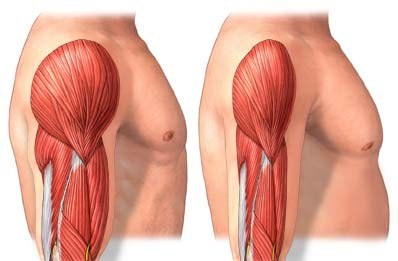
You need not be overweight to have sarcopenia; it all comes down to body composition. Someone within the ‘normal’ range for height and weight is also susceptible to sarcopenia if an imbalanced proportion of that weight comes from fat. In this way, someone who is visibly thin may suffer the same health risks as someone who is visibly overweight if neither of these individuals actively works to maintain a healthy ratio of muscle to body fat. The good news is that you may prevent sarcopenia and its related health consequences by including a variety of exercises into your weekly fitness regimen.
Muscle tissue is generally made up of three types of muscle fibers: Type I, Type II, and Type IIA. Here is a quick description of these muscle types and how to structure your weekly fitness regimen to promote muscular endurance, size, and strength:
Type I: Walking, running, swimming, biking, and lifting light weights are activities that maintain ‘slow-twitch,’ or ‘endurance’ muscle fibers. While engaging in these activities you will burn calories, but Type I muscle fibers may not necessarily contribute to increased metabolism, as they help to keep you going all day but are resistant to growth. It is recommended that healthy adults engage in activities that specifically target Type I muscle fibers for 30 minutes at a time, 5 days a week.
Type II: Power and high-intensity speed tasks require the use of ‘fast-twitch’ muscle fibers that tend to grow larger with use, thus increasing metabolism and overall muscle mass. Sprinting, high intensity interval training and lifting heavy weight quickly are activities that target Type II fibers. It is recommended that healthy adults engage in activities that specifically target Type II muscle fibers for 20 minutes, 2-3 days a week.
Type IIA: Soccer, tennis, lacrosse, and lifting moderate weight recruit an ‘in-between’ type of muscle fiber, mixing endurance and speed muscle capabilities and thus allowing a wide range of movement opportunities. It is recommended that activities that specifically target Type IIA muscle fibers may be substituted for either Type I or Type II activities.
Wondering how you may incorporate all this into your week? Here is a sample of what a weekly exercise schedule might look like for an average person seeking to generally build and maintain muscle mass and integrity:
Sunday: yoga, 1 hour
Monday: full-body resistance routine, 30 minutes/30 minutes moderate treadmill workout
Tuesday: 1 hour Zumba moderate cardio, stretching
Wednesday: sprint intervals vigorous cardio on recumbent bike, 20 minutes/ 30 minutes moderate biking
Thursday: full-body resistance routine, 30 minutes/30 minutes elliptical
Friday: rest day
Saturday: kickboxing class, variation of vigorous and moderate intensity, 1 hour
In addition to formal exercise activity, make an effort to reduce your sedentary pursuits and intersperse bouts of sedentary activity with standing and physical activity. It is also helpful to engage in exercise that you find pleasant and enjoyable, and be sure to periodically challenge yourself to experience enough discomfort to effect positive change.
It is common knowledge that diabetes, heart disease, cancer, and other illnesses and disorders may be linked to an excess of body fat; however, less apparent yet equally threatening to good health is inadequate muscle mass. Regardless of if you are overweight, average weight, or underweight, you may be at risk for sarcopenia, so prevent it now by engaging in a variety of fitness activities throughout your week to build and maintain the muscle that will keep you and your bones healthy and strong.
Sources:
http://www.ncbi.nlm.nih.gov/pubmed/11283518
http://runningtimes.com/Article.aspx?ArticleID=20476&PageNum=1
Add The Sports Daily to your Google News Feed!